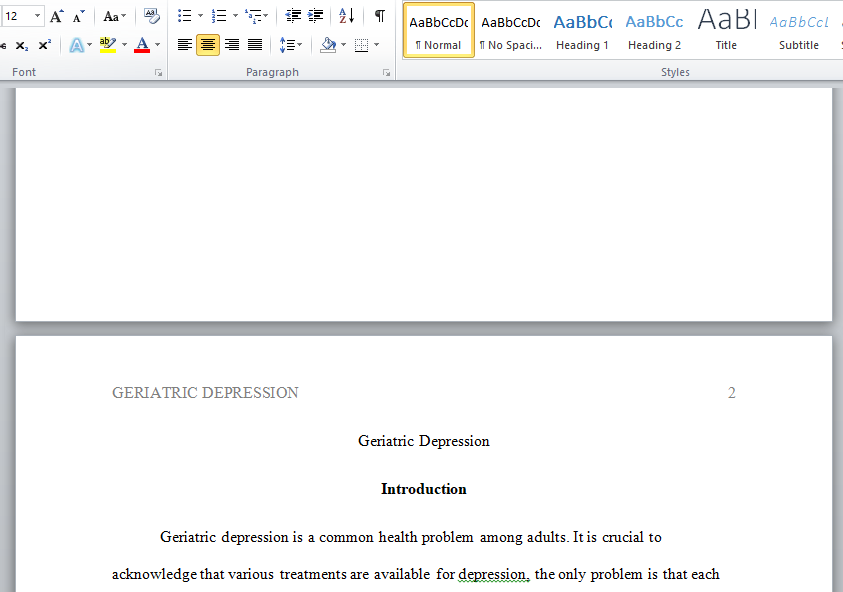Describe geriatric depression based on the scenario presented to you
Decision Point One
 Begin Effexor XR 37.5 mg orally daily
Begin Effexor XR 37.5 mg orally daily
RESULTS OF DECISION POINT ONE
- Client returns to clinic in four weeks
- Client reports that there is no change in depressive symptoms at all
RESULTS OF DECISION POINT ONE
- Client returns to clinic in four weeks
- Client reports that there is no change in depressive symptoms at all
Decision Point Two




RESULTS OF DECISION POINT TWO
- Client returns to clinic in four weeks
- Client reports an improvement in depressive symptoms
- Montgomery- Asberg Depression Rating Scale (MADRS) decreased from 51 to 38 (25% reduction)
Decision Point Three




Guidance to Student
At this point, the PMHNP would have two choices to discuss with the client- the current dose of drug can be maintained if the client is feeling better and is not offering any complaints of side effects. The dose can also be increased at this point, but the PMHNP must counsel client regarding the possibility of side effects. The use of an augmenting agent is not appropriate at this time as we have not reached a maximum dose with Effexor (in fact, 75 mg is still a relatively small dose), displaying primarily SSRI properties only (recall that at lower doses, Effexor exerts a greater effect on serotonergic receptors than norepinephrine at low doses).
BACKGROUND INFORMATION
The client is a 32-year-old Hispanic American male who came to the United States when he was in high school with his father. His mother died back in Mexico when he was in school. He presents today to the PMHNPs office for an initial appointment for complaints of depression. The client was referred by his PCP after “routine” medical work-up to rule out an organic basis for his depression. He has no other health issues with the exception of some occasional back pain and “stiff” shoulders which he attributes to his current work as a laborer in a warehouse.
SUBJECTIVE
During today’s clinical interview, client reports that he always felt like an outsider as he was “teased” a lot for being “black” in high school. States that he had few friends, and basically kept to himself. He describes his home life as “good.” Stating “Dad did what he could for us, there were 8 of us.” He also reports a remarkably diminished interest in engaging in usual activities, states that he has gained 15 pounds in the last 2 months. He is also troubled with insomnia which began about 6 months ago, but have been progressively getting worse. He does report poor concentration which he reports is getting in “trouble” at work.
MENTAL STATUS EXAM
The client is alert, oriented to person, place, time, and event. He is casually dressed. Speech is clear, but soft. He does not readily make eye contact, but when he does, it is only for a few moments. He is endorsing feelings of depression. Affect is somewhat constricted, but improves as the clinical interview progresses. He denies visual or auditory hallucinations, no overt delusional or paranoid thought processes readily apparent. Judgment and insight appear grossly intact. He is currently denying suicidal or homicidal ideation. The PMHNP administers the “Montgomery- Asberg Depression Rating Scale (MADRS)” and obtained a score of 51 (indicating severe depression).
- At each decision point stop to complete the following:
- Decision #1
- Which decision did you select?
- Why did you select this decision? Support your response with evidence and references to the Learning Resources.
- What were you hoping to achieve by making this decision? Support your response with evidence and references to the Learning Resources.
- Explain any difference between what you expected to achieve with Decision #1 and the results of the decision. Why were they different?
- Decision #2
- Why did you select this decision? Support your response with evidence and references to the Learning Resources.
- What were you hoping to achieve by making this decision? Support your response with evidence and references to the Learning Resources.
- Explain any difference between what you expected to achieve with Decision #2 and the results of the decision. Why were they different?
- Decision #3
- Why did you select this decision? Support your response with evidence and references to the Learning Resources.
- What were you hoping to achieve by making this decision? Support your response with evidence and references to the Learning Resources.
- Explain any difference between what you expected to achieve with Decision #3 and the results of the decision. Why were they different?
- Decision #1
- Also include how ethical considerations might impact your treatment plan and communication with clients.
Answer preview :

Word limit : 601
